Content for TS 23.280 Word version: 19.5.1
1…
5…
6
7…
8…
9…
10…
10.1.5…
10.2…
10.2.6…
10.3…
10.6…
10.7…
10.7.3.8…
10.8…
10.9…
10.9.3.9…
10.10…
10.10.3
10.11…
10.12…
10.13…
10.14…
10.15…
10.16…
10.17…
10.18…
10.18.3…
11…
11.5…
A…
B…
C…
E…
10.15 Preconfigured regrouping
10.15.1 General
10.15.2 Information flows for preconfigured regrouping
10.15.3 Regroup with preconfigured group
10.15.3.1 General
10.15.3.2 Preconfigured regroup procedures in a single MC system
10.15.3.3 Preconfigured regroup procedures in multiple MC systems
10.15.3.4 Other preconfigured regroup procedures
...
...
10.15 Preconfigured regrouping |R17| p. 303
10.15.1 General p. 303
The following subclauses specify the information flows and procedures for group and user regrouping using preconfigured groups for a single MC service, and which are utilised by the following MC services:
MC service specific pre-requisites and resultant behaviour by functional entities in performing these procedures are specified in the respective MC service TSs as listed above.
10.15.2 Information flows for preconfigured regrouping p. 304
10.15.2.1 Preconfigured regroup request (MC service client - MC service server) p. 304
Table 10.15.2.1-1 describes the information flow preconfigured regroup request from the MC service client to the MC service server.
| Information element | Status | Description |
|---|---|---|
| MC service ID | M | The MC service ID of the requester. |
| MC service group ID | O | MC service group ID of the regroup group. |
| MC service group ID | M | MC service group ID of the MC service group from which configuration is to be taken. |
| MC service group ID list | O
(see NOTE 1) | List of MC service groups to be regrouped into the group regroup group. |
| MC service user ID list | O
(see NOTE 1) | List of MC service users to be regrouped into the user regroup group. |
| MC service user criteria | O
(see NOTE 1, NOTE 2) | Carries the details of criteria which will be used by the MC service server for determining the participants. For example, it can be a location based criteria to determine the MC service user ID list in a particular area, or it could be tags (e.g. "fire", "medical", "police", etc.), or a combination of tags and location, which is left to implementation. |
|
NOTE 1:
One and only one of these shall be present.
NOTE 2:
This information element is used only for the user regroup procedures.
|
||
10.15.2.2 Preconfigured regroup request (MC service server - MC service client) p. 304
Table 10.15.2.2-1 describes the information flow preconfigured regroup request from the MC service server to the MC service client.
| Information element | Status | Description |
|---|---|---|
| MC service ID | M | The MC service ID of the target MC service group member. |
| MC service group ID | M | MC service group ID of the regroup group. |
| MC service group ID | M | MC service group ID of the MC service group from which configuration is to be taken. |
10.15.2.3 Preconfigured regroup request (MC service server - MC service server) p. 305
Table 10.15.2.3-1 describes the information flow preconfigured regroup request from the MC service server to the MC service server.
| Information element | Status | Description |
|---|---|---|
| MC service ID | M | The MC service ID of the requester. |
| MC service group ID | M | MC service group ID of the regroup group. |
| MC service group ID | M | MC service group ID of the MC service group from which configuration is to be taken. |
| MC service group ID list | O | List of MC service groups to be regrouped into the group regroup group. |
10.15.2.4 Preconfigured regroup response (MC service client - MC service server) p. 305
Table 10.15.2.4-1 describes the information flow preconfigured regroup response from the MC service client to the MC service server.
| Information element | Status | Description |
|---|---|---|
| MC service ID | M | The MC service ID of the responding MC service client. |
| MC service group ID | M | MC service group ID of the regroup group. |
| Result | M | Result of the regrouping operation. |
10.15.2.5 Preconfigured regroup response (MC service server - MC service client) p. 305
Table 10.15.2.5-1 describes the information flow preconfigured regroup response from the MC service server to the MC service client.
| Information element | Status | Description |
|---|---|---|
| MC service ID | M | The MC service ID of the requester of the regrouping operation. |
| MC service group ID | M | MC service group ID of the regroup group. |
| Result | M | Result of the regrouping operation. |
10.15.2.6 Preconfigured regroup response (MC service server - MC service server) p. 305
Table 10.15.2.6-1 describes the information flow preconfigured regroup response from the MC service server to the MC service server.
| Information element | Status | Description |
|---|---|---|
| MC service ID | M | The MC service ID of the responding MC service client. |
| MC service group ID | M | MC service group ID of the regroup group. |
| Result | M | Result of the regrouping operation. |
10.15.2.7 Preconfigured regroup cancel request (MC service client - MC service server) p. 306
Table 10.15.2.7-1 describes the information flow preconfigured regroup cancel request from the MC service client to the MC service server.
| Information element | Status | Description |
|---|---|---|
| MC service ID | M | The MC service ID of the requester. |
| MC service group ID | M | MC service group ID of the regroup group. |
10.15.2.8 Preconfigured regroup cancel request (MC service server - MC service client) p. 306
Table 10.15.2.8-1 describes the information flow preconfigured regroup cancel request from the MC service server to the MC service client.
| Information element | Status | Description |
|---|---|---|
| MC service ID | M | The MC service ID of the target MC service user or MC service group member. |
| MC service group ID | M | MC service group ID of the regroup group. |
10.15.2.9 Preconfigured regroup cancel request (MC service server - MC service server) p. 306
Table 10.15.2.9-1 describes the information flow preconfigured regroup cancel request from the MC service server to the MC service server.
| Information element | Status | Description |
|---|---|---|
| MC service ID | M | The MC service ID of the requester. |
| MC service group ID | M | MC service group ID of the regroup group. |
10.15.2.10 Preconfigured regroup cancel response (MC service client - MC service server) p. 306
Table 10.15.2.10-1 describes the information flow preconfigured regroup cancel response from the MC service client to the MC service server.
| Information element | Status | Description |
|---|---|---|
| MC service ID | M | The MC service ID of the responding MC service client. |
| MC service group ID | M | MC service group ID of the regroup group. |
| Result | M | Result of the regrouping operation. |
10.15.2.11 Preconfigured regroup cancel response (MC service server - MC service client) p. 307
Table 10.15.2.11-1 describes the information flow preconfigured regroup cancel response from the MC service server to the MC service client.
| Information element | Status | Description |
|---|---|---|
| MC service ID | M | The MC service ID of the requester of the regroup removal. |
| MC service group ID | M | MC service group ID of the regroup group. |
| Result | M | Result of the regrouping operation. |
10.15.2.12 Preconfigured regroup cancel response (MC service server - MC service server) p. 307
Table 10.15.2.12-1 describes the information flow preconfigured regroup cancel response from the MC service server to the MC service server.
| Information element | Status | Description |
|---|---|---|
| MC service ID | M | The MC service ID of the requester of the regroup removal. |
| MC service group ID | M | MC service group ID of the regroup group. |
| Result | M | Result of the regroup removal operation. |
10.15.2.13 Preconfigured regroup reject (MC service server - MC service client) p. 307
Table 10.15.2.13-1 describes the information flow preconfigured regroup reject from the MC service server to the MC service client.
| Information element | Status | Description |
|---|---|---|
| MC service ID | M | The MC service ID of the requester of the regrouping. |
| MC service group ID | M | MC service group ID of the regroup group. |
| Reject reason | M | Reason for rejecting the regrouping operation. |
10.15.2.14 Preconfigured regroup reject (MC service server - MC service server) p. 308
Table 10.15.2.14-1 describes the information flow preconfigured regroup reject from the MC service server to the MC service server.
| Information element | Status | Description |
|---|---|---|
| MC service group ID | M | MC service group ID of the regroup group. |
| Reject reason | M | Reason for rejecting the regrouping operation. |
10.15.2.15 Preconfigured user regroup remove request (MC service server - MC service client) |R18| p. 308
Table 10.15.2.15-1 describes the information flow preconfigured user regroup remove request from the MC service server to MC service client.
| Information element | Status | Description |
|---|---|---|
| MC service ID | M | The MC service ID of the MC service user to be removed from the regroup group. |
| MC service group ID | M | MC service group ID of the regroup group from which the MC service user is to be removed. |
10.15.2.16 Preconfigured user regroup remove response (MC service client - MC service server) |R18| p. 308
Table 10.15.2.16-1 describes the information flow preconfigured user regroup remove response from the MC service client to the MC service server.
| Information element | Status | Description |
|---|---|---|
| MC service ID | M | The MC service ID of the MC service user to be removed from the preconfigured regroup. |
| M | Result of the preconfigured user regroup removal operation. |
10.15.2.17 Preconfigured regroup request return (MC service server - MC service client) |R19| p. 308
Table 10.15.2.17-1 describes the information flow preconfigured regroup request return from the MC service server to the MC service client.
| Information element | Status | Description |
|---|---|---|
| MC service ID | M | The MC service ID of the calling party. |
| MC service group ID | O | The MC service group ID to be associated with the preconfigured regroup group call which is either provided by the group call initiator or assigned by the MC service server. This information element shall be present if the authorization result is success. |
| Authorization result | M | Indicate if authorization is success or failure. |
10.15.3 Regroup with preconfigured group p. 309
10.15.3.1 General p. 309
A group regroup may be achieved by regrouping MC service groups into a new MC service regroup group which uses the configuration of a separate preconfigured MC service group. The MC service regroup group configuration needs to be provided to the relevant MC service group members of the MC service groups that will be regrouped in advance of the regrouping operation.
A user regroup may be achieved by regrouping MC service users into a new MC service regroup group which uses the configuration of a separate preconfigured MC service group. The MC service regroup group configuration needs to be provided to the relevant MC service users who will be regrouped in advance of the regrouping operation.
The preconfigured MC service group that provides the configuration is not used as the MC service regroup group itself, it only provides configuration for one or more MC service regroup groups. The MC service group ID of the regroup group is provided by the authorized user when the preconfigured regrouping is carried out.
The MC service regroup group can be specified to be a broadcast or non-broadcast type according to the configuration of the MC service group whose configuration is specified by the regroup request. The broadcast type of regroup is used for one-way communication where only an authorized MC service user is allowed to transmit and all other regroup members are only allowed to receive the communication (e.g. a call from a dispatcher to all regroup members). The non-broadcast type is used for two-way communication where all regroup members can transmit and receive (i.e, the regroup group call behaves like a normal non-broadcast group call).
For group regrouping, if the MC service server has been notified by the group management server that one of the MC service groups that has been requested for regrouping by means of these procedures has already been regrouped, the MC service server shall reject the request for regrouping described in the following procedures.
10.15.3.2 Preconfigured regroup procedures in a single MC system p. 309
The following subclauses define group and user regroup procedures using preconfigured groups within a single MC system.
10.15.3.2.1 Preconfigured Group Regroup formation in a single MC system p. 310
Figure 10.15.3.2.1-1 illustrates the procedure to initiate a group regroup using a preconfigured MC service group. The procedure takes place prior to the establishment of a group call to the MC service regroup group.
Pre-conditions:
- MC service client 2 is an affiliated member of MC service group 1 and MC service client 3 is an affiliated member of MC service group 2.
- The MC service group identity and group configuration for the preconfigured MC service group have been preconfigured in MC service clients 2 and 3, and MC service clients 2 and 3 have received the relevant security related information to allow them to communicate in the MC service regroup group.
- MC service client 1 is authorized to initiate a preconfigured group regroup procedure.
- MC service client 1 is aware of a suitable preconfigured MC service group whose configuration has been preconfigured in the MC service UEs of the group members who will be regrouped.
- In order to be aware whether a group is currently regrouped, the MC service server is subscribed to the group configuration in the GMS.
- The GMS has subscribed to group dynamic data from the MC service server using the procedures defined in subclause 10.1.5.6.
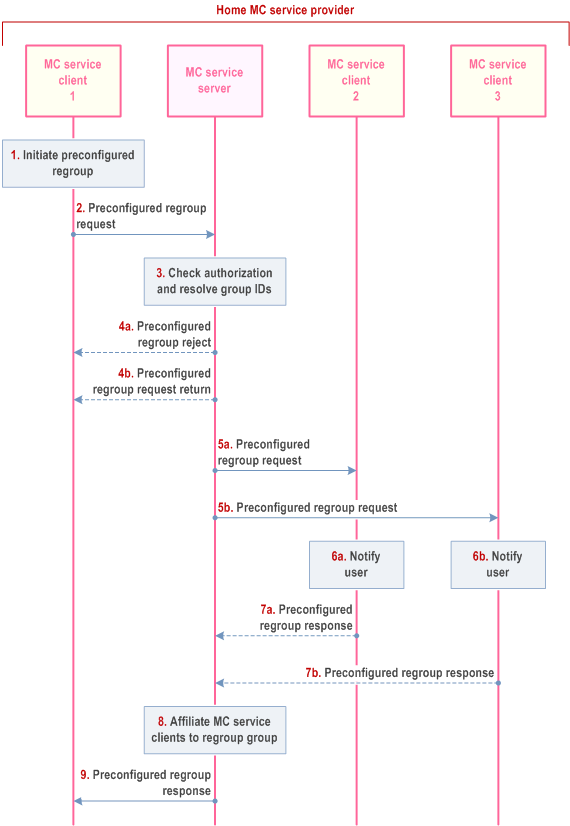
Step 1.
After the group regrouping procedure, the regrouping remains in effect until explicitly cancelled by the procedure in clause 10.15.3.2.3.
MC service client participation in the ongoing regroup persists until the MC service client is no longer affiliated to any of the regrouped groups (group 1 or 2 in this procedure).
MC service client affiliation to the regroup group may cease when the UE's MC service ceases, e.g. when the UE is powered down, or by performing a log-off operation.
The authorized user of MC service client 1 initiates the group regroup procedure, specifying the list of MC service groups to be regrouped (MC service groups 1 and 2), the MC service group ID of the regroup group (if available) and the MC service group ID of the group from which configuration information for the regroup group is to be taken.
Step 2.
MC service client 1 sends the preconfigured regroup request to the MC service server.
Step 3.
The MC service server checks that MC service client 1 is authorized to initiate a preconfigured group regroup procedure, and resolves the group identities of the MC service groups requested in step 1. The MC service server also checks which group members are affiliated to MC service groups 1 and 2. The MC service server may retrieve the configuration for the regroup group from the GMS if that configuration information is not already known to the MC service server. The MC service server also checks that none of the MC service groups that are requested for regrouping are already regrouped by any mechanism. If the preconfigured regroup request is authorized, the MC service server assigns a MC service group ID for this regroup group if:
Step 4a.
- one is not provided in the request or
- the one provided in the request is not accepted.
If the MC service server determines that any of the groups requested for regrouping, including the regroup group, have been regrouped by other group regrouping procedures, the MC service server then sends a preconfigured regroup reject back to MC service client 1 with a reject reason indicating that one of the groups has already been regrouped, and this procedure terminates.
Step 4b.
The MC service server shall send the preconfigured regroup request return message to MC service client 1 containing the below:
Step 5.
- result of whether the preconfigured regroup is authorized or not; and
- the MC service group ID if authorized
If the preconfigured regroup request is not authorized, MC service client 1 shall not proceed with the rest of the steps and this procedure terminates.
Step 5a/b.
The MC service server sends the preconfigured regroup requests to MC service clients 2 and 3.
Step 6a/b.
MC service clients 2 and 3 notify their users of the regrouping.
Step 7a/b.
MC service clients 2 and 3 may send the preconfigured regroup response to the MC service server to acknowledge the regrouping action. These acknowledgements are not sent in response to a multicast transmission of the preconfigured regroup request.
Step 8.
The MC service server affiliates the regrouped MC service clients to the regroup group.
Step 9.
The MC service server sends a preconfigured regroup response to MC service client 1.
10.15.3.2.2 Preconfigured User Regroup formation in a single MC system p. 312
Figure 10.15.3.2.2-1 illustrates the procedure to initiate a user regroup procedure using a preconfigured MC service group. The procedure takes place prior to the establishment of a group call to the MC service regroup group.
Pre-conditions:
- MC service clients 2 and 3 are registered with the MC service server.
- The preconfigured MC service group have been preconfigured in MC service clients 2 and 3, and MC service clients 2 and 3 have received the relevant security related information to allow them to communicate in the MC service user regroup group.
- MC service client 1 is authorized to initiate a user regroup using the preconfigured user regroup procedure.
- MC service client 1 is aware of a suitable preconfigured MC service group whose configuration has been preconfigured in the MC service UEs of the MC service users who will be regrouped.
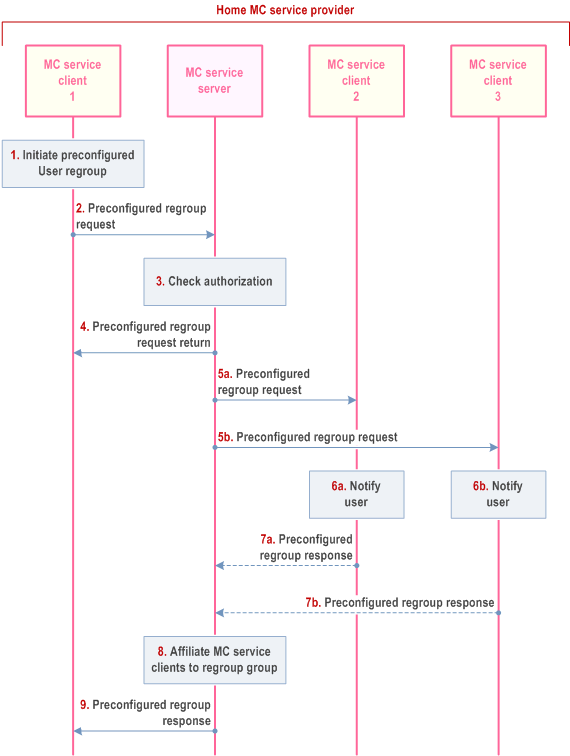
Step 1.
The authorized user of MC service client 1 initiates the user regroup procedure, specifying the list of MC service users to be regrouped (MC service clients 2 and 3), the MC service group ID of the regroup group (if available), and the MC service group ID of the group from which configuration information for the regroup group is to be taken. Alternatively, the MC service client 1 can provide the criteria which allows the MC service server to determine the list of MC service users to be regrouped.
Step 2.
MC service client 1 sends the preconfigured regroup request to the MC service server. The request indicates the list of users to be included in the regroup operation.
Step 3.
The MC service server checks that MC service client 1 is authorized to initiate a preconfigured user regroup procedure. If the preconfigured regroup request is authorized, the MC service server assigns a MC service group ID for this regroup group call if:
Step 4.
- one is not provided in the request or
- the one provided in the request is not accepted.
The MC service server shall send the preconfigured regroup request return message to MC service client 1 containing the below:
Step 5a/b.
- result of whether the preconfigured regroup is authorized or not; and
- the MC service group ID if authorized
The MC service server sends the preconfigured regroup requests to MC service clients 2 and 3.
Step 6a/b.
MC service clients 2 and 3 notify their users of the regrouping in steps 5a and 5b respectively.
Step 7a/b.
MC service clients 2 and 3 may send the preconfigured regroup response to the MC service server to acknowledge the regrouping action. These acknowledgements are not sent in response to a multicast transmission of the preconfigured regroup request.
Step 8.
The MC service server affiliates the regrouped MC service clients to the regroup group.
Step 9.
The MC service server sends a preconfigured regroup response to MC service client 1.
10.15.3.2.3 Preconfigured regroup cancellation in a single MC system p. 313
Figure 10.15.3.2.3-1 illustrates the procedure to cancel a group or user regroup that uses a preconfigured MC service group.
Pre-conditions:
- MC service clients 2 and 3 have been regrouped into a MC service regroup group that uses the configuration of a preconfigured MC service group.
- MC service client 1 is authorized to cancel a group or user regroup that uses a preconfigured MC service group.
- The GMS has subscribed to group dynamic data from the MC service server using the procedures defined in subclause 10.1.5.6.
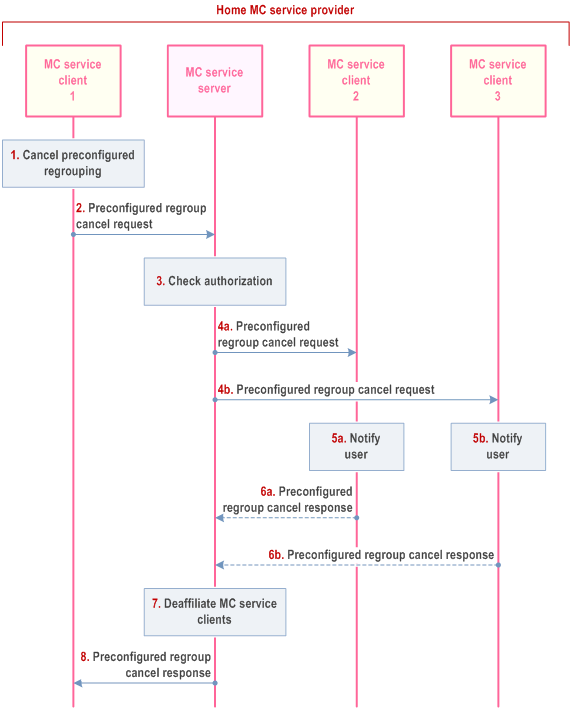
Step 1.
The authorized user of MC service client 1 initiates the cancellation of the regrouping that uses a preconfigured MC service group.
Step 2.
MC service client 1 sends the preconfigured regroup cancel request to the MC service server, specifying the MC service group ID of the regroup group.
Step 3.
The MC service server checks that MC service client 1 is authorized to cancel a regrouping that used a regroup procedure with preconfigured groups.
Step 4.
The MC service server sends the preconfigured regroup cancel request to MC service clients 2 and 3 (steps 4a and 4b respectively).
Step 5.
MC service clients 2 and 3 notify their users of the cancellation of the regrouping in steps 5a and 5b respectively.
Step 6.
MC service clients 2 and 3 may send the preconfigured regroup cancel response to the MC service server to acknowledge the cancellation of the regrouping function. These acknowledgements are not sent in response to a multicast transmission of the preconfigured regroup cancel request.
Step 7.
The MC service server deaffiliates MC service clients 2 and 3 from the MC service regroup group.
Step 8.
The MC service server sends a preconfigured regroup cancel response to MC service client 1.
10.15.3.3 Preconfigured regroup procedures in multiple MC systems p. 314
The following subclauses define group and user regroup procedures using preconfigured groups in multiple MC systems.
10.15.3.3.1 Preconfigured Group Regroup formation in multiple MC systems p. 315
Figure 10.15.3.3.1-1 illustrates the procedure to initiate a group regroup procedure using a preconfigured MC service group, where at least one of the groups to be regrouped is configured in a partner MC system. The primary MC system where the preconfigured group regrouping is initiated does not need to be aware of the list of group members belonging to groups whose group home system is the partner MC system. If the group management server in the primary MC system of the MC service regroup group shares the necessary security related parameters together with the group configuration of the preconfigured MC service group with the group management server in the partner MC system and the group management server in the partner MC system distributes this configuration including those security parameters to its served MC service users according to the procedures in subclause 10.2.7, the primary MC system does not need to be aware of the list of group members of the MC service regroup group that are receiving service in the partner MC system.
The procedure takes place prior to the establishment of a group call to the MC service regroup group.
In this procedure, any gateway MC servers in the primary or partner MC systems are not shown.
Pre-conditions:
- MC service client 1 is authorized to initiated a preconfigured regroup procedure, and is receiving MC service in the primary MC system of MC service client 1.
- MC service client 2 is an affiliated member of MC service group 1 where MC service group 1 is defined in the partner MC system and MC service client 2 is receiving service in the partner MC system of MC service client 1.
- The preconfigured MC service group have been preconfigured in MC service client 2, and MC service client 2 has received the relevant security related information to allow communication in the MC service regroup group.
- In order to be aware whether the group is regrouped, the MC service server is subscribed to the group configuration in the GMS.
- The GMS has subscribed to group dynamic data from the MC service server within the same MC system using the procedures defined in subclause 10.1.5.6.
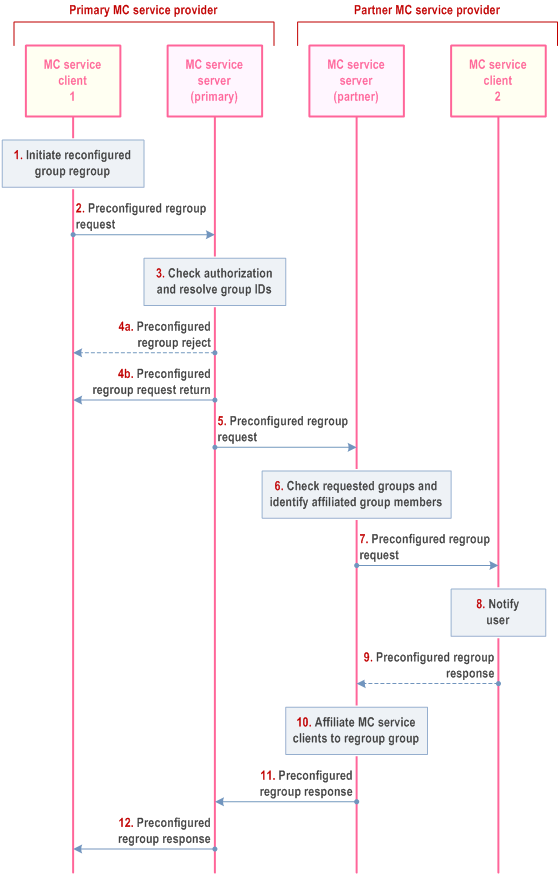
Step 1.
After the group regrouping procedure, the regrouping remains in effect until explicitly cancelled by the procedure in clause 10.15.3.3.3.
MC service client participation in the ongoing regroup persists until the MC service client is no longer affiliated to any of the regrouped groups (group 1 or 2 in this procedure).
MC service client affiliation to the regroup group may cease when the UE's MC service ceases, e.g. when the UE is powered down, or by performing a log-off operation.
The authorized user of MC service client 1 initiates the group regroup procedure, specifying the list of MC service groups to be regrouped including MC service group 1, the MC service group ID of the regroup group (if available) and the MC service group ID of the group from which configuration information for the regroup group is to be taken.
Step 2.
MC service client 1 sends the preconfigured regroup request to the MC service server.
Step 3.
The MC service server checks that MC service client 1 is authorized to initiate a preconfigured group regroup procedure, and resolves the group identities of the MC service groups requested in step 1. The MC service server also checks which group members are affiliated to the requested MC service groups that are homed in the primary MC system. The MC service server identifies any partner systems which are the group home systems for MC service groups identified in the list of groups to be regrouped. The MC service server may retrieve the configuration for the regroup group from the GMS if that configuration information is not already known to the MC service server. The MC service server also checks that none of the MC service groups that are homed in the primary MC system and that are requested for regrouping are already regrouped by any mechanism. If the preconfigured regroup request is authorized, the MC service server assigns a MC service group ID for this regroup group if:
Step 4a.
- one is not provided in the request, or
- the one provided in the request is not accepted.
If the MC service server determines that any of the groups requested for regrouping, including the regroup group, have been regrouped by other group regrouping procedures, the MC service server then sends a preconfigured regroup reject back to MC service client 1 with a reject reason indicating that one of the groups has already been regrouped, and this procedure terminates.
Step 4b.
The MC service server shall send the preconfigured regroup request return message to MC service client 1 containing the below:
Step 5.
- result of whether the preconfigured regroup is authorized or not; and
- the MC service group ID if authorized
The MC service server sends the preconfigured regroup requests to the MC service server in the partner MC system.
Step 6.
The partner MC service server checks the status of any MC service groups hosted by that partner MC service server, and identifies affiliated group members of any of the identified MC service groups (both MC service groups that are hosted in the primary MC system and MC service groups that are hosted in the partner MC system) that are receiving MC service service in the partner MC system, which include MC service client 2.
Step 7.
The partner MC service server sends the preconfigured regroup request to MC service client 2.
Step 8.
MC service client 2 notifies the user of the regrouping.
Step 9.
MC service client 2 may send the preconfigured regroup response to the partner MC service server to acknowledge the regrouping action. This acknowledgement is not sent in response to a multicast transmission of the preconfigured regroup request.
Step 10.
The partner MC service server affiliates the regrouped MC service client 2 to the regroup group.
Step 11.
The partner MC service server sends a preconfigured regroup response to the primary MC service server.
Step 12.
The primary MC service server sends the preconfigured regroup response to MC service client 1.
10.15.3.3.2 Preconfigured User Regroup formation in multiple MC systems p. 317
Figure 10.15.3.3.2-1 illustrates the procedure to initiate a user regroup procedure using a preconfigured MC service group, where at least one of the MC service users to be regrouped is homed in a partner MC system. It is assumed that the group management server in the primary MC system of the MC service regroup group shares the necessary security related parameters together with the group configuration of the preconfigured MC service group with the group management server in the partner MC system and the group management server in the partner MC system distributes this configuration including those security parameters to its served MC service users according to the procedures in subclause 10.2.7.
The procedure takes place prior to the establishment of a group call to the MC service regroup group.
In this procedure, any gateway MC servers in the primary or partner MC systems are not shown.
Pre-conditions:
- MC service client 1 is homed in the primary MC system and is receiving service in the primary MC system.
- MC service client 2 is homed in the partner MC system and is receiving service in the partner MC service system of MC client 1.
- The MC service group identity and group configuration for the preconfigured MC service group have been preconfigured in MC service client 2, and MC service client 2 has received the relevant security related information to allow communication in the MC service regroup group.
- MC service client 1 is authorized to initiate a preconfigured user regroup procedure.
- MC service client 1 is aware of a suitable preconfigured group whose configuration has been preconfigured in the MC service UEs of the MC service users who will be regrouped.
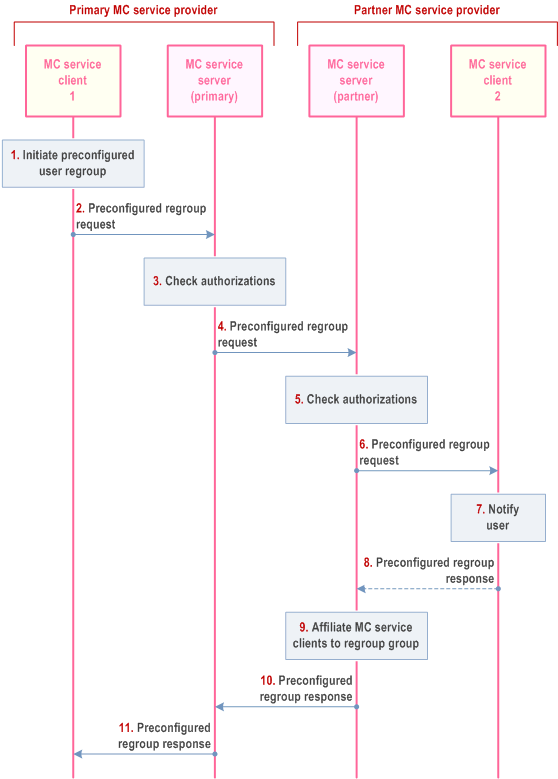
Step 1.
The authorized user of MC service client 1 initiates the user regroup procedure, specifying the list of MC service users to be regrouped including MC service client 2, the MC service group ID of the regroup group, and the MC service group ID of the group from which configuration information for the regroup group is to be taken.
Step 2.
MC service client 1 sends the preconfigured regroup request to the primary MC service server. The request indicates the list of users to be included in the regroup operation.
Step 3.
The primary MC service server checks that MC service client 1 is authorized to initiate a preconfigured user regroup procedure.
Step 4.
The primary MC service server sends the preconfigured regroup requests to the MC service server in the partner MC system.
Step 5.
The partner MC service server checks that the primary MC service server is authorized to include MC service users homed in the partner system.
Step 6.
The partner MC service server sends the preconfigured regroup request to MC service client 2.
Step 7.
MC service client 2 notifies the user of the regrouping.
Step 8.
MC service client 2 may send the preconfigured regroup response to the partner MC service server to acknowledge the regrouping action. This acknowledgement is not sent in response to a multicast transmission of the preconfigured regroup request.
Step 9.
The partner MC service server affiliates the regrouped MC service client 2 to the regroup group.
Step 10.
The partner MC service server sends a preconfigured regroup response to the primary MC service server.
Step 11.
The primary MC service server sends the preconfigured regroup response to MC service client 1.
10.15.3.3.3 Preconfigured regroup cancellation in multiple MC systems p. 319
Figure 10.15.3.3.3-1 illustrates the procedure to cancel a group or user regroup that uses a preconfigured MC service group where multiple MC systems were involved in the regrouping.
Pre-conditions:
- MC service client 2 has been regrouped into the MC service regroup group, and is receiving service in the partner MC system of the regroup group.
- MC service client 1 is authorized to cancel a regrouping that uses a preconfigured MC service group, and is receiving service in the primary MC system of the regroup group.
- The GMS has subscribed to group dynamic data from the MC service server within the same MC system using the procedures defined in subclause 10.1.5.6.
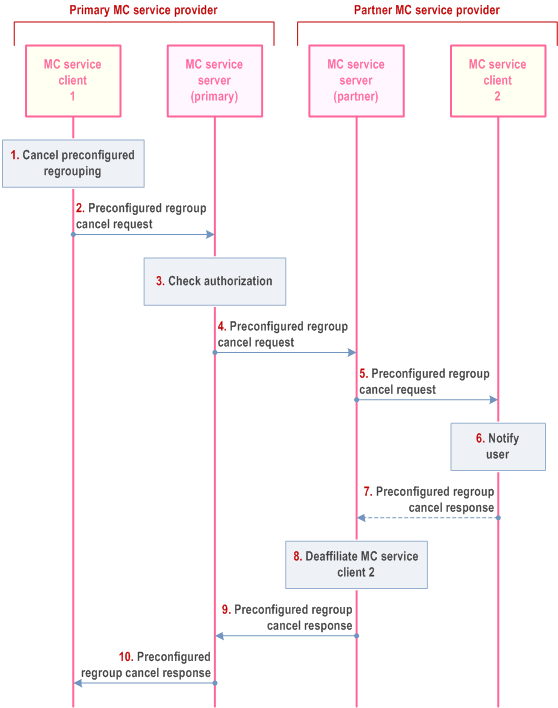
Step 1.
The authorized user of MC service client 1 initiates the cancellation of the regrouping that uses a preconfigured MC service group.
Step 2.
MC service client 1 sends the preconfigured regroup cancel request to the MC service server, specifying the MC service group ID of the regroup group.
Step 3.
The MC service server checks that MC service client 1 is authorized to cancel a regrouping that uses a preconfigured group regroup procedure.
Step 4.
The primary MC service server sends the regroup cancel request to the partner MC service server.
Step 5.
The partner MC service server sends the preconfigured regroup cancel requests to MC service client 2.
Step 6.
MC service client 2 notifies the user of the cancellation of the group regrouping.
Step 7.
MC service client 2 may send the preconfigured regroup cancel response to the partner MC service server to acknowledge the cancellation of the regrouping function. This acknowledgement is not sent in response to a multicast transmission of the preconfigured regroup cancel request.
Step 8.
The partner MC service server deaffiliates MC service client 2 from the MC service regroup group.
Step 9.
The partner MC service server sends the preconfigured regroup cancel response to the primary MC service server.
Step 10.
The primary MC service server sends a preconfigured regroup cancel response to MC service client 1.
10.15.3.3.4 Preconfigured group regroup rejection in multiple MC systems p. 320
Figure 10.15.3.3.4-1 illustrates the case where the procedure to initiate a group regroup with multiple MC systems using a preconfigured MC service group described in subclauses 10.15.3.3.1 commences, but where the request for the regroup is rejected by the partner MC service server. The rejection can occur, for example because one of the groups hosted by the partner MC service server is already regrouped by other group regrouping procedures.
In this procedure, any gateway MC servers in the primary or partner MC systems are not shown.
Pre-conditions:
- MC service client 1 is authorized to initiated a preconfigured regroup procedure, and is receiving MC service in the primary MC system of MC service client 1.
- In order to be aware whether the group is regrouped, the MC service server within the same MC system is subscribed to the group configuration in the GMS.
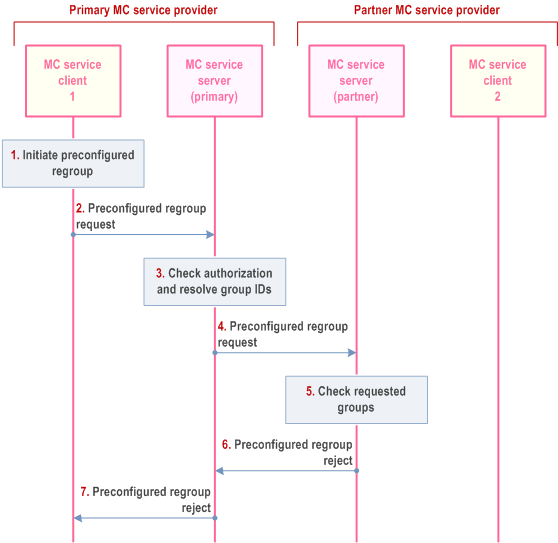
Step 1.
The authorized user of MC service client 1 initiates the group regroup procedure, specifying the list of MC service groups to be regrouped including MC service group 1, the MC service group ID of the regroup group and the MC service group ID of the group from which configuration information for the regroup group is to be taken.
Step 2.
MC service client 1 sends the preconfigured regroup request to the MC service server.
Step 3.
The MC service server checks that MC service client 1 is authorized to initiate a preconfigured group regroup procedure, and resolves the group identities of the MC service groups requested in step 1. The MC service server also checks which group members are affiliated to the requested MC service groups that are homed in the primary MC system. The MC service server identifies any partner systems which are the group home systems for MC service groups identified in the list of groups to be regrouped. The MC service server may retrieve the configuration for the regroup group from the GMS if that configuration information is not already known to the MC service server. The MC service server also checks that none of the MC service groups that are homed in the primary MC system and that are requested for regrouping are already regrouped by any mechanism.
Step 4.
The MC service server sends the preconfigured regroup requests to the MC service server in the partner MC system.
Step 5.
The partner MC service server checks the status of any MC service groups hosted by that partner MC service server, and determines that one or more requested MC service groups has already been regrouped by another group regrouping procedure.
Step 6.
The partner MC service server sends a preconfigured regroup reject to the primary MC service server, indicating the reason for rejection.
Step 7.
The primary MC service server sends a preconfigured regroup reject to MC service client 1, indicating the reason for rejection.
10.15.3.4 Other preconfigured regroup procedures p. 322
10.15.3.4.1 Adding newly affiliated user to preconfigured group regroup p. 322
Figure 10.15.3.4.1-1 illustrates the procedure to add a newly affiliated user to an in-progress preconfigured MC service group regroup operation.
Pre-conditions:
- The MC service client is a member of a MC service group that is part of an in-progress preconfigured group regroup operation.
- The MC service group identity and group configuration for the preconfigured MC service group has been preconfigured in the MC service client, and the MC service client has received the relevant security related information to allow it to communicate in the MC service regroup group.
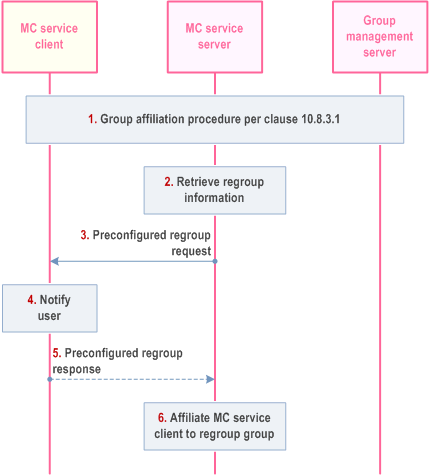
Step 1.
The MC service client affiliates to an MC service group that is currently part of an in-progress preconfigured group regroup. The affiliation follows the procedure in section 10.8.3.1 of this specification.
Step 2.
The MC service server retrieves the MC service group ID of the regroup group and the MC service group ID of the group from which configuration information for the regroup group is to be taken.
Step 3.
The MC service server sends the preconfigured regroup request to the MC service client.
Step 4.
The MC service client notifies the user of the regrouping.
Step 5.
The MC service client may send the preconfigured regroup response to the MC service server to acknowledge the regrouping action. These acknowledgements are not sent in response to a multicast transmission of the preconfigured regroup request.
Step 6.
The MC service server affiliates the regrouped MC service client to the regroup group.
10.15.3.4.2 Updating the MC service ID list in a preconfigured regroup group based on user regroup |R18| p. 323
Figure 10.15.3.4.2-1 illustrates the procedure to add or remove an MC service user based on the MC service user criteria known at the MC service server.
Preconditions:
- A preconfigured regroup group has been established.
- The MC service server has selected MC service user 2 to participate in the preconfigured regroup group based on MC service user criteria known at the MC service server.
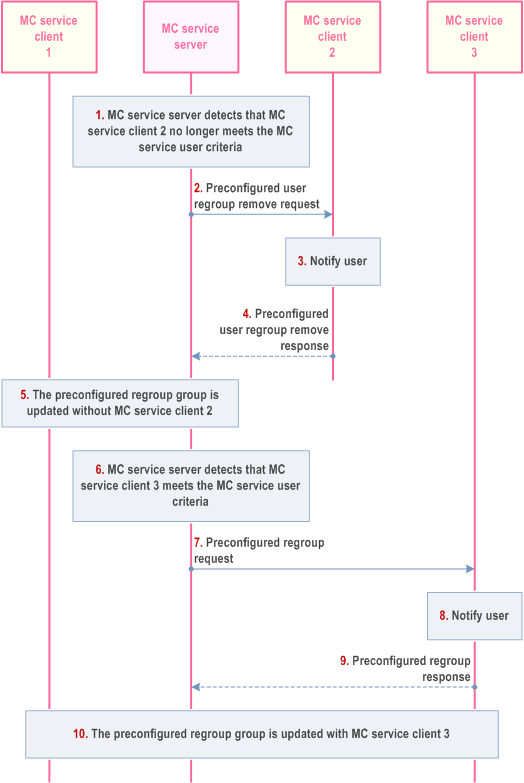
Step 1.
The MC service server detects that MC service client 2, which has been earlier included in the preconfigured regroup group, no longer meets the MC service user criteria known at the MC service server.
Step 2.
The MC service sends MC service client 2 a preconfigured user regroup remove request.
Step 3.
The MC service client 2 notifies the MC service user of the preconfigured user regroup removal.
Step 4.
The MC service client 2 may send the MC service server a preconfigured user regroup remove response to acknowledge the preconfigured user regroup removal.
Step 5.
The MC service server updates the preconfigured regroup group (including the MC service user ID list) and potential group communication.
Step 6.
The MC service server detects that the MC service client 3 meets the MC service user criteria.
Step 7.
The MC service server sends the MC service client 3 a preconfigured regroup request.
Step 8.
The MC service client 3 notifies the MC service user of the preconfigured regroup request.
Step 9.
The MC service client 3 may send the MC service server a preconfigured regroup response.
Step 10.
The MC service server updates the preconfigured regroup group (including the MC service user ID list), and potential group communication.
10.15.3.4.3 Adding a user to regroup group due to communication request to the group being regrouped |R19| p. 324
Figure 10.15.3.4.3-1 illustrates the procedure of adding a user to regroup group due to the user initiating a comunication request to the group involved in an in-progress preconfigured MC service group regroup.
Pre-conditions:
- The MC service client is an affiliated member of MC service group A that is part of an in-progress preconfigured group regroup with MC service groups B and C.
- MC servicec group D is being used as the regroup group.
- The MC service client has missed the preconfigured regroup request message (e.g. poor signalling conditions, race condition).
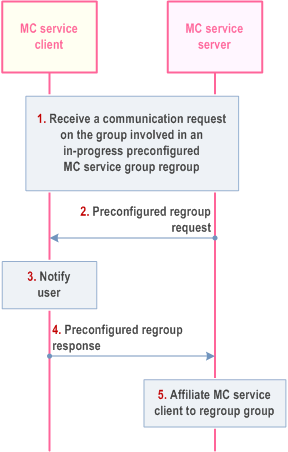
Step 1.
The MC service client attempts to start a communication on MC service group A. The MC service server identifies that the MC service group A is currently part of an in-progress preconfigured group regroup. In this case, the MC service server rejects the communication. The procedure of signalling interactions between the MC service client and the MC service server for MCPTT, MCVideo and MCdata is specified in TS 23.379, TS 23.281, TS 23.282 accordingly.
Step 2.
The MC service server sends the preconfigured regroup request to the MC service client containing the MC service group ID of the preconfigured group, and the MC service group ID of the regroup group.
Step 3.
The MC service client notifies the user of the regrouping procedure.
Step 4.
The MC service client sends the preconfigured regroup response to the MC service server to acknowledge the regrouping action.
Step 5.
The MC service server affiliates the regrouped MC service client into the regroup group.
10.15.3.4.4 Regroup group cancel notification due to communication request to the cancelled regroup group |R19| p. 325
Figure 10.15.3.4.4-1 illustrates the procedure of notifying about the cancellation of the regroup group when a user initiates a communication to a regroup group after the MC service group regroup has been cancelled.
Pre-conditions:
- The MC service client is a member of MC service group A that was part of an in-progress preconfigured group regroup with MC service groups B and C that has been cancelled. MC service group D was used as the MC service regroup group.
- The MC service client has missed the preconfigured regroup cancel request message (e.g. poor signalling conditions, race condition).
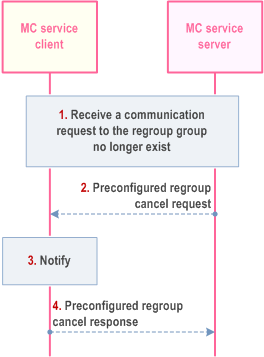
Step 1.
The MC service client attempts to start a communication on MC service group D, which is the regroup group. The MC servce server identifies regroup group is no longer active or exist.
Step 2.
The MC service server may send the preconfigured regroup cancel request to the MC service client.
Step 3.
The MC service client may notify the user of the regrouping cancellation.
Step 4.
The MC service client may send the preconfigured regroup cancel response to the MC service server to acknowledge the regrouping cancellation.